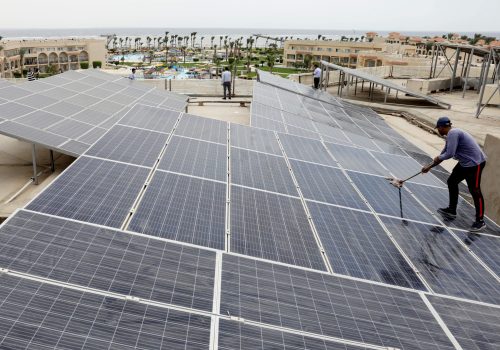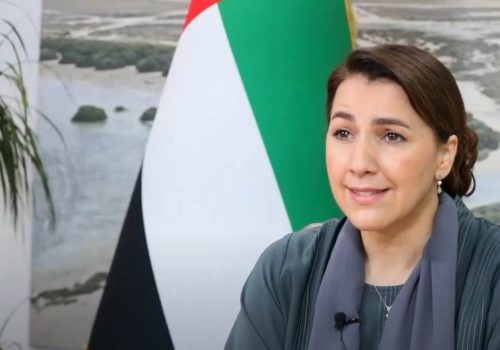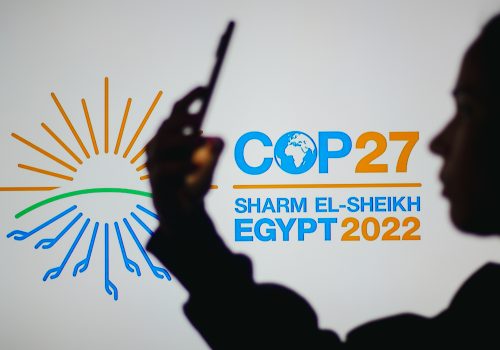Developing countries need a loss and damage fund for climate change. How can COP28 make it happen?
One of the major outcomes of COP27 in Egypt, which occurred from November 6-18, 2022, was the agreement to establish a Loss and Damage Fund (L&D). Loss and damage has been discussed for over a decade, starting with COP16 in Mexico, but little progress has been achieved over that time. The concept entails looking at the irreversible losses and damages incurred by climate change impacts on states, such as loss of land, ecosystems, heritage, biodiversity, and people.
Loss and damage differs from mitigation and adaptation. Mitigation refers to the amount of Green House Gas (GHG) emissions that states need to reduce to reach the 1.5 C target (34.7 F). Adaptation refers to methods that will help states adapt to a warming climate irrespective of emissions reductions, such as coastal protection measures, heat resistant crops, and more. Loss and damage, however, implies that although we are reducing emissions and adapting to a warmer world, there are still complete losses of ecosystems, species, land, and people that require attention and consideration—and, ultimately, compensation.
Mitigation and adaptation have long been part of already-established climate finance mechanisms. Meanwhile, L&D is a new paradigm that not only requires a separate pot of money, but also needs significantly more resources, since irreversible losses may cost more to cover.
While following the cash flow of climate finance, it has been observed that, of the $100 billion pledged by developed countries to developing countries, a maximum of $80 billion has been dispersed since the Paris Agreement of 2015. Since the full allotment of climate finance for mitigation and adaptation has yet to be fulfilled by developed countries, one must wonder where and how this new pot of money for L&D will come from.
In March 2023, the first transitional committee met in Luxor, Egypt to discuss the L&D fund. It made promising steps to claim that the fund could be finalized and set in place by COP28 in the United Arab Emirates (UAE) from November 30-December 12.
The talks did not address controversial issues such as sources of financing or the type of projects the fund would cover, but there was agreement over a road map to create a fund. This came with the understanding and responsibility that part of the outcome in COP28 must be the definition of clear guidelines for financing the L&D fund, in addition to drafting the operational guidelines for the scope and mechanism of the fund itself.
Deciding the scope and mechanism of the L&D fund is also quite tricky, as setting criteria for which countries are eligible for financing and under what conditions is extremely contentious. After the devastating floods in Pakistan in 2022—which killed over seventeen hundred people, with damages having been estimated at $14.9 billion and economic losses registering at $15.2 billion—the country representatives were vocal at COP27 about the necessity for compensation and assistance to developing countries in regard to the complete eradication of land.
Small Island Developing States (SIDS), including Vanuatu, have also spoken up about the complete encroachment of the sea on their islands and the erasure of their countries, heritage, and entire existence. The SIDS—with Barbados leading the narrative against this climate injustice—have also been forthcoming in arguing how essential the money from L&D is to their survival.
So, how does the mechanism decide who gets priority in financing? This is a daunting task for the transitional committee. The aim is to set criteria for economic and non-economic losses to put a structure in place for such a framework.
Many have ultimately criticized the actual outcome and agreement of the L&D fund in COP27, stating that it is essentially the failure of the United Nations Framework Convention on Climate Change (UNFCCC) system as a whole. For decades, states have been meeting regularly to come to an agreement on providing climate finance to developing countries that have not contributed to the climate crisis. At the same time, states have attempted to put requirements on each other to reduce Greenhouse Gas (GHG) emissions. That being said, the latest assessments have shown that the pledged emissions reductions have not been sufficient to meet the 1.5 C target set in Paris. In fact, the world is heading towards an average temperature increase of 2.5-2.8 C (36-37 F).
Many countries in the developing world have come to the consensus that they will be left with irreversible damages in the near future if other developed countries do not sufficiently reduce their GHG emissions or disburse climate finance as promised. The battle and persistence for an L&D fund by these countries is a matter of survival. L&D is the last lifeboat for these countries after decades of struggle to achieve some form of global climate justice. How the L&D fund will be structured and operated will be a telling sign of whether the last lifeboat can save lives or not.
Lama El Hatow is a nonresident fellow with the Atlantic Council’s empowerME Initiative.
Further reading
Thu, Oct 13, 2022
Egypt has made some progress on human rights and the environment in preparation for COP27. But there’s still more to be done.
MENASource By Shahira Amin
Skeptics are questioning Egypt's leadership of the climate talks, citing human rights concerns and unideal environmental policies.
Thu, Oct 27, 2022
UAE Minister of Climate Change and Environment Mariam Al Mheiri: Middle East at the heart of new climate reality
Event Recap By
An Atlantic Council conference on climate change and security in the Middle East brought together high-level officials from across the region to explore innovative solutions.
Thu, Sep 22, 2022
Egypt is hosting COP27. What are the expectations?
MENASource By Lama El Hatow
As the host country for the 2022 United Nations Climate Change Conference, Egypt has a huge role to play during its presidency of the event, as all eyes will be geared towards how the country can lead by example.
Image: Villager Mujahid Ali dewaters his fields in the flood-hit village Gozo, Pakistan January 17, 2023. Thomson Reuters Foundation/Waqar Mustafa


